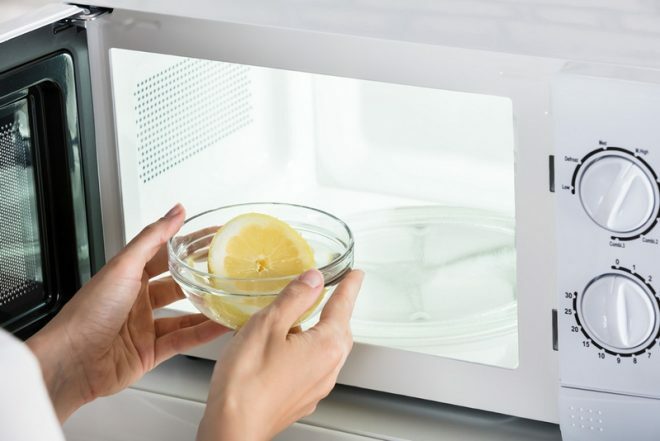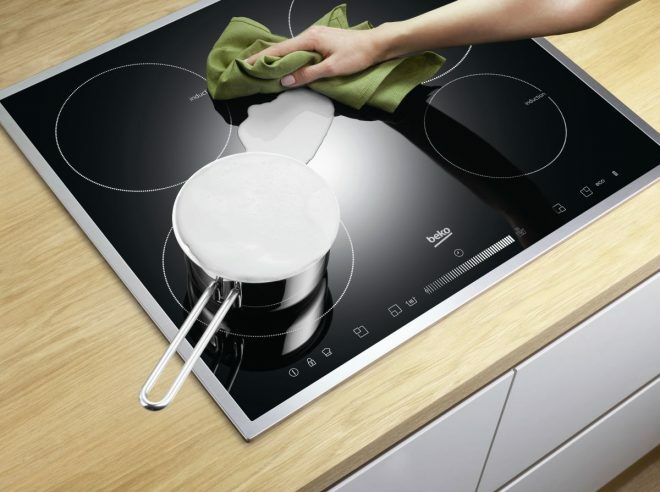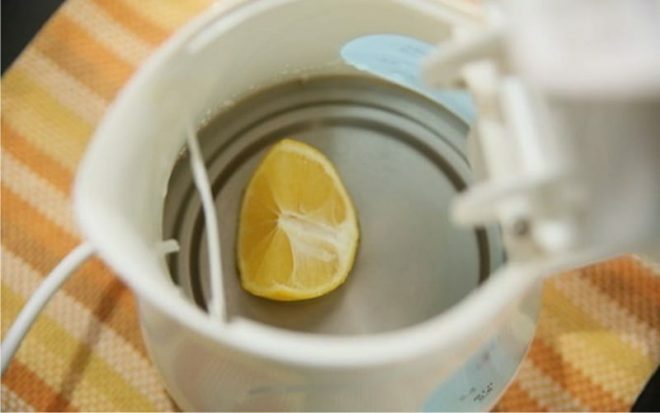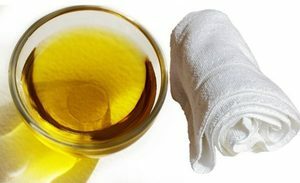 Kitchen towels are more likely to get dirty than other household textiles. Only the rags get dirty more, with which they sweep the crumbs off the table and wipe the countertops. However, for a long time, most housewives switched to using disposable cleaning wipes. With towels in the kitchen, things are more complicated. Paper ones are convenient for cooking, cleaning and other purposes, but wiping the dishes is more pleasant and more convenient with classic cloth ones. And how to keep them clean and bleach them with vegetable oil, we will consider in this article.
Kitchen towels are more likely to get dirty than other household textiles. Only the rags get dirty more, with which they sweep the crumbs off the table and wipe the countertops. However, for a long time, most housewives switched to using disposable cleaning wipes. With towels in the kitchen, things are more complicated. Paper ones are convenient for cooking, cleaning and other purposes, but wiping the dishes is more pleasant and more convenient with classic cloth ones. And how to keep them clean and bleach them with vegetable oil, we will consider in this article.
Everything would be too simple if there were no periodically unforeseen situations in the kitchen, when something spilled, boiled out and ran away, splashed. Tea towels take on many of these bumps.
Attention! Earned on our website kitchen designer. You can familiarize yourself with it and design your dream kitchen for free! May also come in handy wardrobes designer.
What is the result? As a result, we have an unpleasant smell of fabric, grease stains, yellowness. But everyone wants to see snow-white towels that complement the pleasant interior of a clean kitchen with sparkling dishes.
There is a need to come up with the most optimal and effective way of washing and bleaching them.
How do I keep my tea towel clean?
There are various ways to remove grease and other stains from fabrics. For this, a wide variety of means can be used. The most popular options are:
- Washing. Many have long abandoned hand washing, and machine washing is much more efficient.
- Soak. More precisely, wash with presoak.
- Boiling. An old but effective trick.
- Whitening. It implies the use of special industrial bleaches or folk remedies.
In case of severe contamination, you have to combine these methods to achieve the desired result.
Let us dwell in a little more detail on each method.
Washing
 The easiest way to remove dirt is to wash. The type of fabric and the degree of soiling will tell you the wash modes and the required cleaning agents.
The easiest way to remove dirt is to wash. The type of fabric and the degree of soiling will tell you the wash modes and the required cleaning agents.
Choosing a temperature:
- White cotton - 90 degrees.
- Colored cotton or blended fabric - 60 degrees.
It should be borne in mind that for colored fabrics, a washing temperature of 40 degrees is often indicated. The manufacturer recommends just such a mode so that the color does not suffer. However, this temperature is clearly not enough to remove complex grease stains. Experience shows that most of the colored fabrics, from which the towels are made, are sufficiently resistant to temperatures of 60 degrees and withstand repeated washings.
If the towel is clean enough and it is time to wash, no special conditions are required. If there is strong dirt on the fabric, you will have to pre-soak it in a special solution. There are several options for preparing such a solution:
- Soda is added to the washing powder. Moreover, they use not only soda ash, which is traditionally used for washing, but also baking soda. Washing soda is more active and is used for stubborn stains, baking soda is softer, but it also washes and deodorizes perfectly. You need to soak for at least four hours. You should not use this method for colored fabrics, soda does not have the best effect on dyeing.
- Plain table salt is added to cold water. One tablespoon of salt is needed per liter of water. The method is quite simple, but it effectively removes tea and coffee stains, which are the leading contaminants of kitchen textiles. This method can be used for fabrics of any composition and color, they will not suffer.
Boiling
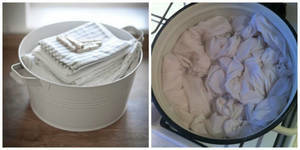 How many childhood memories come at the mention of boiling. But after all, this method of removing contaminants is losing popularity undeservedly. Of course, with the advent of modern chemical detergents, there is no need to boil everything, as our grandmothers did. However, when boiling is used, less aggressive detergents can be used.
How many childhood memories come at the mention of boiling. But after all, this method of removing contaminants is losing popularity undeservedly. Of course, with the advent of modern chemical detergents, there is no need to boil everything, as our grandmothers did. However, when boiling is used, less aggressive detergents can be used.
Boiling solution can be prepared in several ways:
- Laundry soap shavings with the addition of baking soda or soda ash.
- A mixture of washing powder with oxygen bleach. For ten liters of water - half a glass of each product.
- Chlorine bleach and table salt in equal parts. For ten liters - 500 g each.
- Washing powder with the addition of hydrogen peroxide. For ten liters of water, you need to take one glass of powder and half a glass of peroxide. This is a very effective method, but the tissue should not remain in this solution for more than thirty minutes.
Use an enamel pot or bucket as a container for boiling. Only white fabrics can be boiled.
Whitening
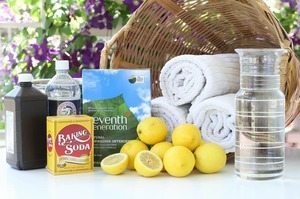 Whitening is most effective in removing dirt on towels from the kitchen. Even stubborn stains can be removed without leaving a trace.
Whitening is most effective in removing dirt on towels from the kitchen. Even stubborn stains can be removed without leaving a trace.
It makes no sense to describe the treatment with the help of industrially produced bleaches, because the instructions for their use are always indicated on the packaging of such products. Therefore, consider whitening towels using homemade recipes:
- Laundry soap and boric acid. Contaminated areas are thoroughly lathered. A certain amount of shavings of laundry soap and two or three tablespoons of boric acid are added to ten liters of water. After four hours of soaking, the towels can be washed as usual.
- Table mustard. It is enough to stir dry mustard in hot water and soak towels in the resulting solution for three hours. This is the oldest method of all, bleaching fabrics with mustard began many decades ago.
- Ammonia. For one part of water, you need to take one part of ammonia. Apply the resulting solution directly to the stains and let it dry. Next - wash in the usual way.
- Hydrogen peroxide. A solution is prepared at the rate of 5-10 ml of peroxide per liter of water. Towels are soaked for six to seven hours, then they need to be washed in the usual way.
- Bleach with soda ash. For ten liters of warm water, take 500 grams of soda and bleach. Do not soak the fabric immediately. The solution should be allowed to stand for a day, then it must be filtered to remove undissolved lumps. After that, you can soak towels in the solution for up to five hours. The procedure ends with a regular wash.
- Vegetable oil. So we come to the fun part! We set ourselves the goal of answering the question of how to whiten towels using it at home. The first impression of the proposed method is always associated with surprise and disbelief. But don't jump to conclusions. Let's take a closer look.
How to wash kitchen towels with vegetable oil?
There are many uses for cleaning fabrics, but we will look at three of the most well-known methods.
Method one
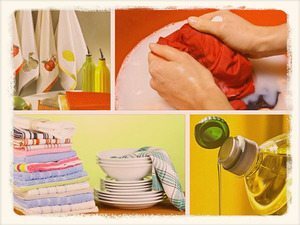 For ten liters of water, add:
For ten liters of water, add:
- 4 tablespoons of vegetable oil;
- 4 tbsp. tablespoons of dry bleach;
- 300 g of washing powder.
The ingredients should be thoroughly mixed in water. Then, for two to three hours, the towels are soaked in the resulting solution. Contaminants soften under the influence of active substances. Finally, you need to remove dirt and the solution itself with a regular wash. Can be washed in any washing machine. It is recommended to add additional rinses to better remove oil residues from the fabric.
This method can also be used for colored fabrics if the dye is strong enough. The oil base softens the aggressive effects of the bleach.
Method two
To prepare the second version of the solution for 10 liters of water, you will need:
- 2 tbsp. tablespoons of vinegar essence (it can be replaced with one glass of table vinegar);
- 2 tbsp. spoons of soda;
- 80 g of washing powder;
- 2 tbsp. tablespoons of vegetable oil.
The resulting solution is stirred. You can soak towels in it overnight. This is quite convenient. In the morning, it will remain to wash them in an ordinary washing machine. It is advisable to choose an intensive rinse or increase the number of cycles.
If the reaction of soda and vinegar is too active, you can replace the soda in the solution with bleach. In this case, the effectiveness of the impact will not be affected.
Method three
This option is even more interesting, because now we will put already washed towels into the prepared solution.
For ten liters of water, add:
- 2 tbsp. tablespoons of vegetable oil;
- 2 tbsp. spoons of bleach;
- 300 g of washing powder.
We prepare the solution on the basis of hot water. We immerse the previously washed towels in it, leave them until the liquid cools completely. We take out and rinse thoroughly to remove the remnants of the active ingredients. Then it is enough to dry the fabric. This method should also help remove stubborn dirt.
Improving the efficiency of home bleaching
There are some guidelines to help you whiten kitchen towels more effectively at home:
- Vegetable oil is added to all solutions last. If you do the opposite, stirring the rest of the ingredients will be quite difficult.
- Towels should be placed in the prepared solution dry. Pre-moistened contamination is much more difficult to break down.
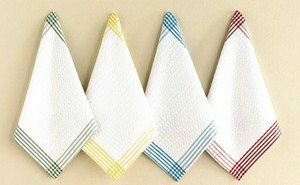 It’s easy to guess that using the vegetable oil trick is not only possible for cleaning towels. The large number of posts on the housekeeping forums suggests that the addition of oil helps to restore the original cleanliness of underwear, pillowcases, sheets and duvet covers.
It’s easy to guess that using the vegetable oil trick is not only possible for cleaning towels. The large number of posts on the housekeeping forums suggests that the addition of oil helps to restore the original cleanliness of underwear, pillowcases, sheets and duvet covers.
It is very important for mothers and their babies that such whitening methods are completely safe and will not harm the child's body. Therefore, more and more solutions with the addition of oil are used for washing baby clothes, diapers, shirts, blouses and sliders. Lingerie bleached with oil is non-allergenic. This is especially important for underwear that is in contact with the skin.
Although the effectiveness of oil-based products initially seems questionable, experience has shown their high cleaning power.
Vegetable oil can be used not only for whites, but also for colored fabrics. It helps to remove fresh and stubborn stains. The ability to remove traces of tea and coffee, fat, wine, berry juice and even tomato juice has been tested in practice.
The effectiveness of using vegetable oil is based on the fact that it helps to soften the stubborn dirt. And in a softened form, dirt can be easily removed by subsequent washing or even a simple rinse.
Noticing the appearance of stains that cannot be cleaned in the usual way, do not rush to get upset and throw out enough new things. One of the suggested methods is likely to help solve the problem. Kitchen towels, linens and other textiles will be clean at a minimum cost.
Video: how to quickly bleach kitchen towels
average rating 0 / 5. Number of ratings: 0
No ratings yet. Be the first to rate.
